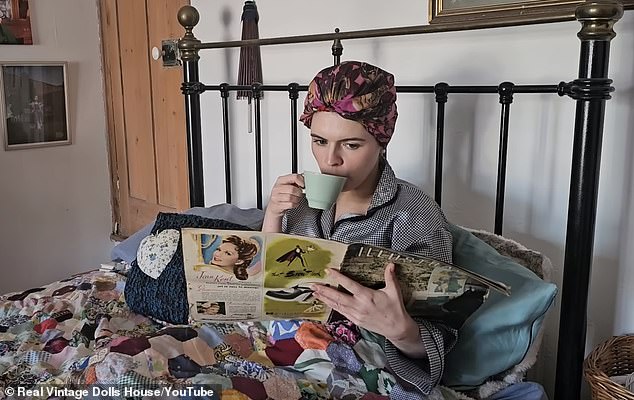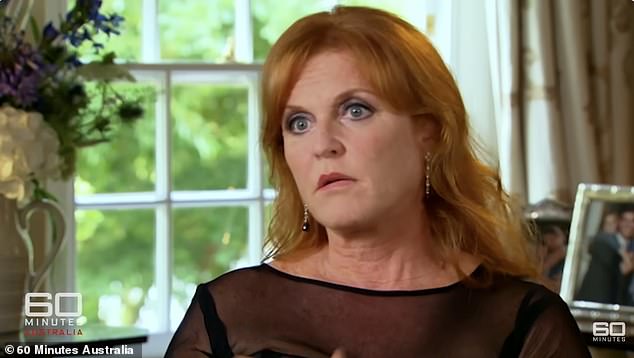A woman revealed she managed to pay off her mortgage in just eight years by living with she was in the 1940s.
Hannah Hall, from Nottingham, who fell in love with the era after watching wartime films with her late grandfather, Henry, often shares nostalgic and educational YouTube videos of life during wartime Britain.
In the current era of relentless consumerism, Hannah, who works as a medical examiner’s officer for the NHS, has defied the odds by embracing a lifestyle straight out of the 40’s that can still work today.
In her latest video on the Real Vintage Dolls House channel, from inside her stunning vintage-inspired semi- detached two-bedroom house in inner-city Nottingham,Hannah has shared her 10 frugal living tips to help others also gain financial freedom.
The 31-year-old, who grew up in a single-income household with limited money, revealed her frugal mindset was shaped early on thanks to her mother, who taught her the value of hard work and making do.
She explained: ‘My mum is one of my greatest financial teachers, and for as long as I can remember, we’ve lived in a certain way to get by.But as I’ve gotten older and become interested in history, I discovered another incredible teacher, our ancestors.’
After a lifetime of renting and with just a modest £5,000 deposit to their name, Hannah and her mother managed to get a mortgage together.
Hannah added: ‘We then paid it off in eight years through vigorous saving, choosing our provider very carefully year by year, cutting out on luxuries, and overpaying when we could.
‘I do think that the tactics that we use daily are still worth sharing. So let’s dive into the past to help us gain some security in our present.’

Hannah Hall, from Nottingham,revealed she managed to pay off her mortgage in just eight years by adopting some of the 1940’s money saving habits
1. Make do and mend: Second hand living
Hannah revealed nearly every item in her home has been handed down to her or bought from a charity shop.
She explained: ‘Of course, buying secondhand does limit your choices. But I actually like that because it lessens my decision fatigue, and if something isn’t quite right, then I can use my agency and skills to repair it or amend it.
‘And if I don’t have these skills, then I can learn them, often for free. In the 40s, they called this make, do, and mend. Reusing or repairing items means that they have a longer lifespan.
‘You’re freeing yourself from the upgrade loop. And often that means saving money.’
One of the greatest benefits of broadening your skill set, Hannah said, is the freedom to get creative.
Instead of immediately spending money on upgrades or renovations, she began looking at parts of her home that she could DIY.

Hannah, who fell in love with the era after watching wartime films with her late grandfather, Henry, often shares nostalgic and educational YouTube videos of life during wartime Britain
2. Cooking from scratch
Back in the 1940s, Hannah revealed people were forced to stretch rationed food as far as possible and that spirit of resourcefulness still holds value today.
For her, cooking from scratch became a cornerstone of frugal living. With the soaring cost of eating out and takeaways, it is a rare treat in her household.
She said: ‘Even the food in the supermarkets can sometimes be expensive. Our pantry is modest and filled with foods and ingredients that can go far. Potatoes, for example, are a real godsend and can be used in so many different recipes.
‘Making soups is a brilliant lunch option.
‘Cooking one whole chicken and then spreading it over different meals or one homemade cottage pie that can provide me and my mum with dinners for the next five to six days.’
The content creator previously spent a weekfollowinga 1940s ration diet whichchanged her relationship with food forever.
3. Bring coffee with you in a flask

In an era of relentless consumerism, the content creator has defied the odds by embracing a lifestyle straight out of the 40s that can still work today
Hannah explained: ‘Tea and coffee. Everyone knows the trope of tea keeping the nation going during the war.
‘But making your own hot drinks at home and then popping them in a flask rather than spending it at Starbucks can make a surprising difference month by month.’
Hannah also doesn’t keep fizzy drinks in the house, and alcohol is rarely on the menu.
Her main source of hydration is simple tap water, with a bit of squash for her mum, who has never liked the taste of plain water.
4. Dig for victory: Grow your own vegetables
Hannah started growing her own fruit and vegetables in her garden and the results have been both satisfying and practical.
Seeing the fruits of her labour in the garden have become one of her greatest joys, but more importantly, it’s also helped stock her kitchen with fresh, homegrown ingredients.
She said: ‘I recently made a lovely pasta sauce from my homegrown tomatoes, and it tasted so much better than shop bought.
‘Even without a garden, little window sill allotments can be a great option, even just for growing herbs like basil or mint.’
5.Embrace a capsule wardrobe

Hannah started growing her own fruit and vegetables in her garden and the results have been both satisfying and practical
Hannah swears by sticking to a capsule wardrobe to save money,a concept that dates back to the 1940s.
Back then, people owned fewer clothes, but each item was carefully chosen for quality, durability, and versatility.
She has adopted the same approach, a modest selection of well-made pieces that can be mixed and matched, worn for years, and styled in multiple ways.
She explained: ‘In the 1930s and 40s, the average woman would have about 60 items of clothing in her wardrobe, buying around 10 new items a year.
‘Whereas today, we have an average of 300 items in our wardrobe with over 60 items being bought new per year lasting around two years.
‘Whereas I try to have clothing that could be worn for all seasons of life. One of the items in my wardrobe leads nicely into number six, keeping warm.
6. Keep warm the old fashioned way
When the temperature drops, Hannah doesn’t rush to turn on the heating, she layers up instead.
From chunky knit cardigans and fleecy dressing gowns to woolly socks and cosy blankets, she relies on classic, comforting ways to stay warm.
She said: ‘We did decide to pay to have a multi-fuel burner installed in our living room. And yes, this incurred an upfront cost, but it is a great option to keep the main living space warm.
‘And we can burn off cut pieces of wood that we’ve accumulated or eco-friendlier coal that lasts a really long time, but to be honest, it doesn’t burn quite as easily.
‘In the 40s and all throughout history, keeping a main room warm in the home and closing all the doors was a common occurrence.
‘But if you don’t have a fireplace, then a hot water bottle is another great choice to warm your bed before you get into it or to just cuddle as you watch a film.’
7. Exercise at home
She said: ‘I have always been someone that enjoys home workouts. In the 40s, they would recommend a morning workout and stretches, all equipment free.
‘And when I followed one of these workouts, I could quite easily see one of the ways that they kept so slender. As my income has improved, I have now found a gym. But rather than going to a chain gym, I found a little community centre thatprovides gym and swim for only £20 a month.’
8. Walk whenever you can
If it’s safe and practical, Hannah always chooses to walk. Not only does it keep her active but it also cuts down on travel costs.
In true 1940s fashion, she often walked or cycled to work, just as people did during wartime when cars were a luxury and fuel was scarce.
9. Do more, buy less
One of the greatest lessons she’s learned from the 1940s is how to find joy in the simple things.
Back then, people made the most of what they had, opting for experiences over expenses.
She said: ‘Picnics, walks, a cup of tea at a cafe, all experienced driven rather than wallet driven. These days, I admit it’s hard to find things that you don’t have to pay for.’
10. Homegrown self-care
Forget salon visits and pricey beauty treatments, Hannah prefers to keep things simple and do it herself.
From trimming her own hair to skipping professional manicures, she’s embraced a more old-fashioned, homegrown approach to self-care.
She said: ‘Our grandmothers gave lots of useful and cheap beauty hacks. Vaseline to set your eyebrows, homemade soap, or even washing your hair less and styling it more.
‘Hair that isn’t freshly washed is often easier to style and curl, and if my hair isn’t freshly clean, I find that I experiment more with it.
‘There are ways that we can separate ourselves from constant consumerism.’
Hannah concluded: ‘As I look back on the 1940s, a period of war and terror, I not only learn about people’s sheer bravery, but their determination to live as happily as they could, even when it felt like everything was against them.’









